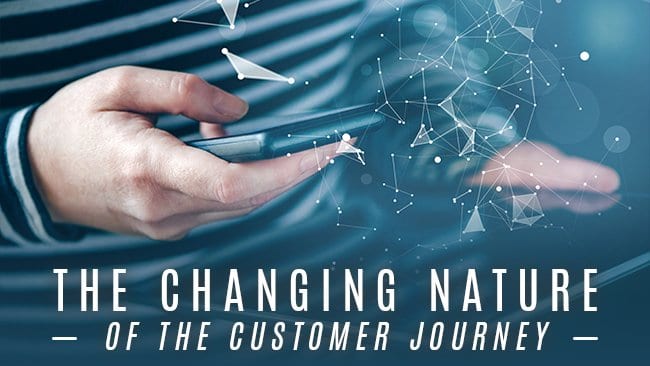
In today’s omnichannel world, the customer journey is no longer a straight line from A to B, but rather a meandering path, encompassing multiple touchpoints.
It has long been viewed that the extent of a contact center’s achievemets in effectively dealing with the various touchpoints that make up the customer experience is related to high scores on the different touchpoints. These are seen as a measure of success in how well the customer is treated.
However, when looked at from the customer point of view, it is never these individual transactions through which they interact with the business being good that makes the difference – customers expect their entire journey to be easy, well-handled and comfortable for them if they are to deem the experience a success.
More crucially, the modern customer journey has changed significantly in the past two decades. It wasn’t that long ago that if a customer needed information, wanted to make a complaint, or request a new, different or upgraded service; their only option was to phone the company’s call center. While this may have proved painful for the customer, due to long hold times and the possibility of being shifted up the center’s chain of command until the problem was resolved, it was easy enough for the company to track.
Today, however, the customer journey has evolved to encompass multiple channels that are very different to voice. In fact, by the time a customer calls an agent today they will typically have been through several other channels in an attempt to solve their problems or get answers to their questions. For example, they may have tried some kind of self-service approach, searched the company website or connected via Web chat or e-mail. It is even increasingly likely that they have reached out to the business on social media.
And understanding how the customer journey has evolved to encompass these new digital channels is key to providing them with a service that creates a good customer experience, in order to boost customer happiness and keep them loyal to your organization. Remember that although the customer journey has changed, the end result remains the same – anyone contacting your business via any channel wants their problem resolved or their question answered, and they want it done as soon as possible.
Let’s have a quick look at some of the major new stops that so often form part of the modern customer journey:
Web chat: While some customers, usually older ones, are a bit reticent about using something like Web chat, those customers that do more often than not approach the channel differently to the way they would with a standard voice call. Customers not only use this channel to request help for product issues, but they will also even use it to seek buying advice and comparisons with competing products. It tends to be viewed by users as a more personable channel than plain voice, and if handled right, can be a great means for agents to upsell to the customer.
Social media: this is one of the major stops on most customer journeys, whether or not the organization actually has a social media channel of its own. While it is a favorite channel of communication for customers, in that it is seen as a very comfortable way for them to communicate, it can also serve as a platform for customers to vent if the service received is not up to the standard they expect. From the contact center perspective, social media is about engagement, which means responding to posts by a customer rapidly and in a fitting manner.
IVR: Probably the most widely used channel outside of voice in most contact centers, IVR is seen as a way to cost-effectively service customer issues. However, customers seldom view it the same way, finding IVRs to be cumbersome, time-consuming and infuriating. Often, user interfaces confront the customer with so many options to choose from that they will abandon the IVR session. In such a case, the IVR system may drive customers to unnecessarily select live agent support over self-service, raising inbound call volume, prolonging average handle time and poorly affecting the customer experience. This is exactly what contact centers want to avoid, particularly in a situation where the customer journey is already taking them through multiple touchpoints.
So how does the modern contact center ensure that the journey remains satisfying, regardless of the manner in which the customer chooses to proceed with it?
In the IVR’s case, it is actually quite easy to implement a solution to make the user’s journey simpler and more efficient. All that is required is to turn the existing IVR system into a visual interface that can be displayed on a smartphone screen. A Visual IVR is able to easily guide customers through a user-friendly visual interface, making the customer journey simpler and faster.
With regard to Web chat, social media and e-mail as channels, ensuring the customer journey continues in a positive fashion is mostly about agent training. Modern contact center agents need to be cross-trained in order to ensure they are skilled across multiple channels. After all, these channels generally require a focus on different skills, most notably spelling and grammar, for those channels where contact tends to made via the written word. A clear understanding of tone is also required, as social posts adopt a much more easy-going approach than the more formal e-mail approach, while Web chat may need a chattier style of communication.
What this all boils down to is that the customer journey is far more complex than it used to be, and companies now need to design and deliver experiences seamlessly across a wide range of different channels. It is now about ensuring you have a comprehensive view of the customers’ current experience, that you properly understand the customer’s physical and emotional journey, and ultimately, that you design ways to improve it.
Businesses that fail to appreciate the context of these situations and manage the cross-functional, end-to-end customer journey will find that this journey will likely end in a negative outcome for the enterprise. Nobody wants to undertake a terrible journey more than once, so if your customer’s journey is not satisfactory, you face the possibility of negative consequences that may include anything from dramatically higher call volumes to lost sales and even customer churn.
In contrast, those that provide the customer with the best experience from start to finish along the journey can expect to enhance customer satisfaction, improve sales and retention, reduce end-to-end service cost and strengthen employee satisfaction.
In the end, it pays to remember that every single chat, e-mail, call, or social media post is part of a task that a customer is trying to complete. The quicker that the contact center is able to identify the journey the customer is on, the quicker it can take action to help them to complete it.
And in an omnichannel world, understanding the customer’s journey requires context – if your agents are always aware, at any stage of the journey, what steps the customer has already taken along this journey, you will be able to optimize it and ensure that the customer’s journey has a happy ending.
[About the author] Dylon Mills is the Director of Marketing Content Strategy & Development at Uniphore. As such, Dylon’s main responsibilities are to strategize, create and deliver content for Uniphore’s product portfolio that align with the global Go-To-Market strategy, corporate positioning, and marketing campaigns. Dylon’s prior work experience includes Product Management at one of the top Fortune 500 Technology companies, Symantec Corporation. Outside of work, Dylon enjoys problem-solving and any project that includes building/tinkering with tools. Dylon holds a BS Consumer Economics from the University of Georgia.
Dylon Mills is the Director of Marketing Content Strategy & Development at Uniphore. As such, Dylon’s main responsibilities are to strategize, create and deliver content for Uniphore’s product portfolio that align with the global Go-To-Market strategy, corporate positioning, and marketing campaigns. Dylon’s prior work experience includes Product Management at one of the top Fortune 500 Technology companies, Symantec Corporation. Outside of work, Dylon enjoys problem-solving and any project that includes building/tinkering with tools. Dylon holds a BS Consumer Economics from the University of Georgia.
)